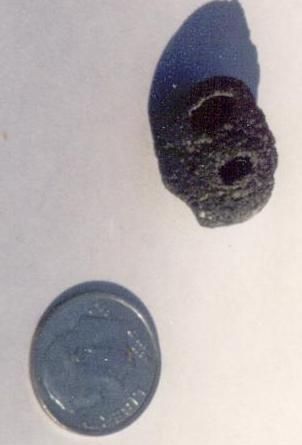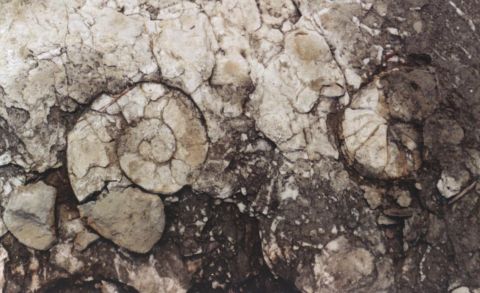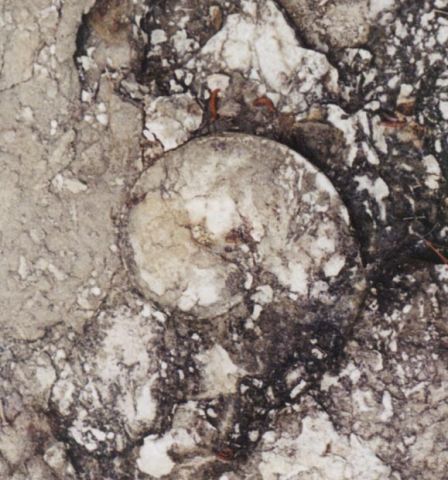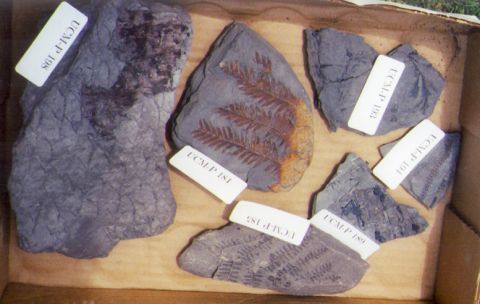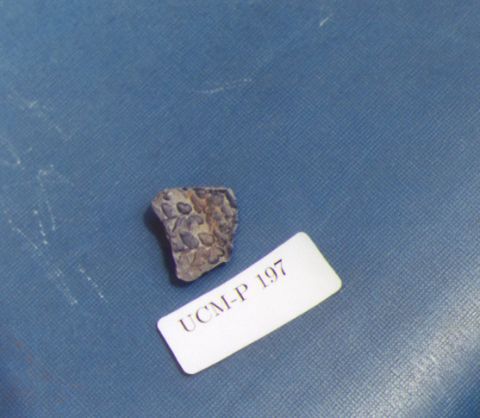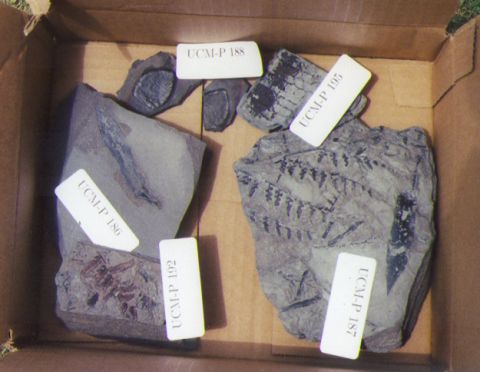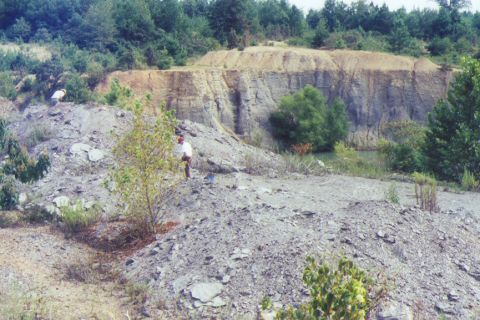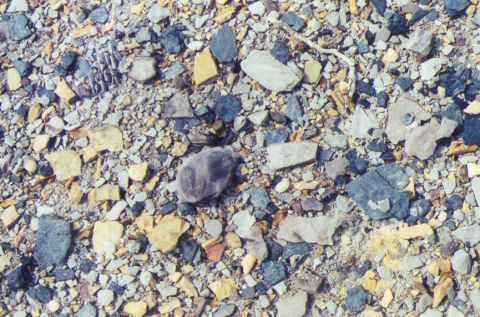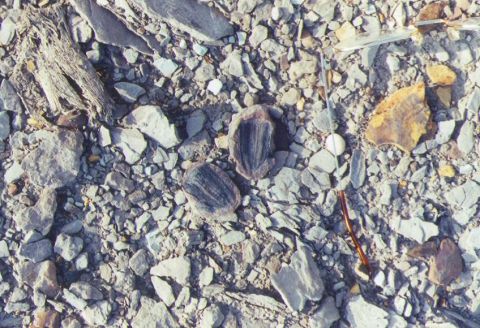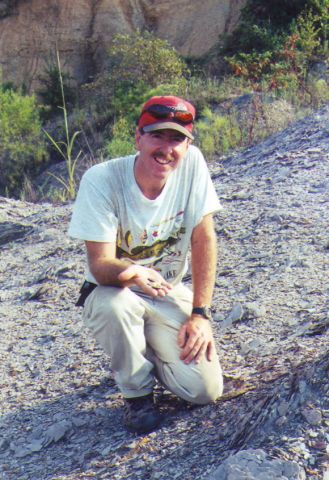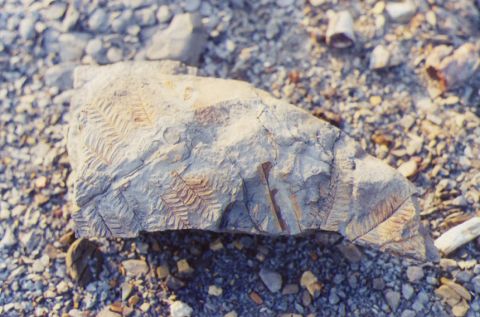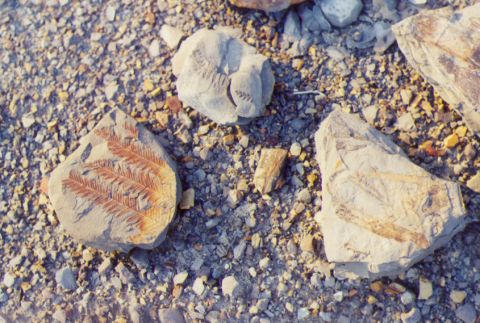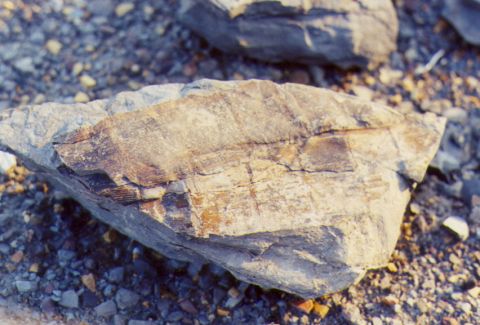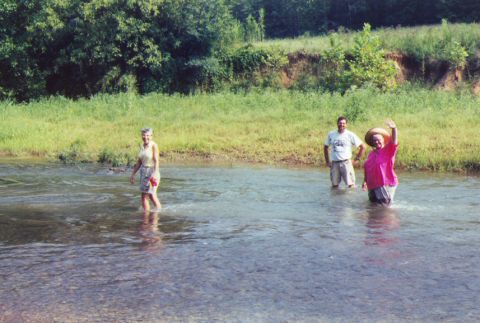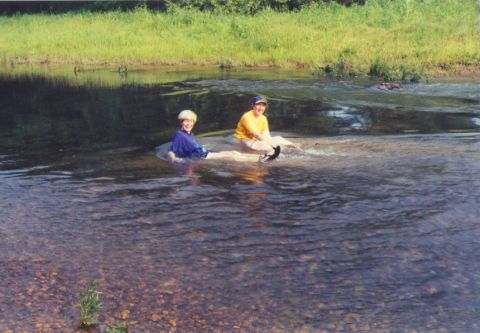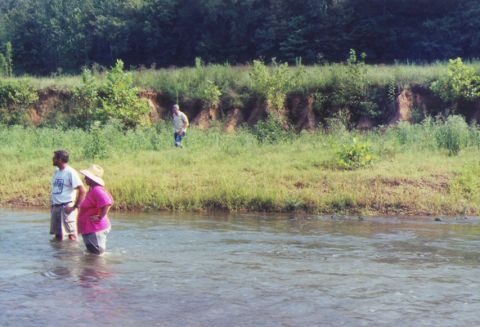Pycnodont tooth (phacodus punctatus)
2001
January 20, 2001 - Cherokee Co, AL
BPS members collected in Cherokee County, Alabama. This site is the Conasauga Formation of the Cambrian, and numerous trilobites were found.
NOTE: We lost server access due to the illness of the administrator of our host server. It was over a year before he was back at work, and no field trip reports were created during that time period. These brief memos are simply place-holders for the trip. Periodically, old photos do turn up and get scanned in.
February 17, 2001 - Franklin Co, AL
March 31, 2001 - Bibb Co, AL
March 5, 2001 - Press Release - Ancient Alabama Animal Tracks
ANCIENT ALABAMA ANIMAL TRACKS INSPIRE AMATEUR FOSSIL COLLECTORS
TO DOCUMENT FINDS
"The handprints, which include long, curving toes with easily-distinguished pads on the tips, are nearly as big as my own," exclaimed Dr. Jim Lacefield of Tuscumbia. "This was a huge beast. Although I had read that some amphibians reached rather large size in the Pennsylvanian, in all my collecting in Coal Age rocks in Alabama I have never seen any that were anywhere nearly this large," he said.
Lacefield, a part-time biology and Earth science instructor at the University of North Alabama, and author of a recently published book on Alabama fossils, was describing remarkable fossil footprints of an ancient alligator-sized animal that he had collected at a surface coal mine in Walker County owned by the New Acton Coal Mining Company of Warrior, Alabama. Lacefield was visiting the mine on an outing early last year with members of the Birmingham Paleontological Society (BPS), an active group of local amateur fossil hunters who had received permission from the company to salvage fossils from the area.
The mine had been discovered only a few months earlier to be an unusually good source of fossil vertebrate trackways by Ashley Allen, an Oneonta High School science teacher who is also a member of the BPS. A student in Allen's class had alerted him to the site owned by his grandmother, Mrs. Dolores Reid. Fossils connected with vertebrate animal life (that is, animals with a backbone) are of great paleontological significance since they represent some of the most advanced forms of life that developed on Earth at the time and are usually very rare.
Since Allen's discovery, the Walker County mine has been the focus of an extraordinary salvaging effort by BPS members that has led to a remarkable cooperation with professional paleontologists. The trackways collected from the mine are of vertebrate as well as invertebrate animals that lived during the Late Carboniferous Period of Earth history, known to North American geologists as the Pennsylvanian Period. This Period dates back 310 million years to a time when much of the Earth (particularly North America and Europe) was covered with great tropical swamps that eventually laid down many of the vast coal reserves we use today. (In fact, the Pennsylvanian Period is also often referred to as the "Coal Age.") During the past 15 months, mainly through the efforts of the BPS, more than 800 track specimens have been salvaged from the residual rock piles left after the coal mining was discontinued.
According to Dr. Anthony J. Martin of the Department of Environmental Sciences, Emory University, the Walker County mine is "one of the best vertebrate track sites for the time period in question in the world." Martin is an ichnologist, a paleontologist who studies "trace" fossils, or traces of ancient activity. Tracks are trace fossils since they show what an animal was doing but not specifically what it looked like. Martin became involved in the study of the Walker County mine tracks through the insight of Steve Minkin, an Anniston geologist and BPS member who was very active in collecting trackways from the site. Recognizing the scientific importance of the tracks, Minkin proposed a series of meetings at which amateur collectors would bring all of their track finds from the mine to one place for photographic documentation and detailed inspection by professional paleontologists. The first of these events, jokingly dubbed a "Track Meet", was held on August 19, 2000 at the Alabama Museum of Natural History on the campus of the University of Alabama. Dr. Ed Hooks, Museum curator, fully supported the event and was instrumental to its success. The event was also sponsored by the Geological Survey of Alabama. A second meeting, called "Track Meet 2", was held at Oneonta High School on October 14, 2000 to document all finds since the first track meet. The third and final track meet, called "Track Meet 3", will be held on May 12, 2001 at the Anniston Museum of Natural History and will photographically document all tracks found since Track Meet 2 and since the final reclamation of the mine in December, 2000.
Although no fossils of the ancient animals that made the tracks have been found, the trackways record the dynamics of life on land nearly 90 million years before the first dinosaurs walked the Earth. According to Dr. Jack Pashin of the Geological Survey of Alabama, the tracks occur at the head of an area that was once a tidal mud flat much like the one seen today in Mobile Bay. The environment would have been far enough inland to be fresh water rather than salt water, but it would have been an area still dominated by one or more daily tides. At ebb tide, animals would walk or creep across the still wet mud and impress the tracks of their activities. The mud was soft and fine enough that even small creatures could leave well-defined tracks. The best-preserved tracks were probably impressed so deeply that they were buried before they had a chance to be altered in any significant way. Once buried, they were effectively removed from further disturbance for the next 310 million years.
The tidal flat was evidently near a rich forest of tall tree-like lycopods (primitive spore-bearing plants whose foliage resembled that of modern clubmosses), giant horsetails (plants roughly like reeds or bamboo), and tree-sized seed ferns, because among the tracks BPS members also found bark impressions, pith casts, fern impressions, and reproductive organs of a wide variety of ancient plants that are now extinct. It is known that these types of plants could only thrive in fresh-water swamps. Insect life was probably abundant in the forest, and it is significant that one insect fossil was found at the Walker County mine. Dr. Prescott Atkinson, a Birmingham pediatrician and BPS member, found a pair of 4-inch long wing impressions of an extinct relative of modern dragonflies. This is the only fossil found at the site that gives direct information on the actual appearance of a creature that lived in the area. Because of the high quality of many of the plant fossils found at the same site, Track Meet 3 will include a "Plant Fest", where the best plant specimens from the mine will be photographically documented and examined by professional paleobotanists (scientists who study fossil plant life).
Many of the tracks found by BPS members are of amphibians, animals whose modern relatives include frogs and salamanders. These tracks include striking five-toed patterns over a wide range of sizes from less than a centimeter to the size of an adult human hand. Other tracks are those of animals that may be transitional between amphibians and reptiles. Although we do not know precisely what these creatures looked like, they would have been some of the earliest vertebrates to be fully adapted to dwelling on dry land.
Tracks of other animals, mostly invertebrates, have also been found at the Walker County mine. Apparently, the area was very popular with horseshoe crabs, animals that are related more to scorpions and spiders than to conventional crabs. Today's horseshoe crabs are "living fossils", and the ancient ones that left the tracks probably looked very similar to modern ones. The complex pattern of legs on horseshoe crabs, and the way they walk in water, can explain a wide variety of tracks found at the Walker County mine. Horseshoe crabs in large numbers also left "resting traces", simple impressions of their leg patterns. Evidence also for early fish swimming in shallow areas has been found in the form of wavy tracks where it is thought that fins lightly touched the bottom. Numerous worm burrows have also been found.
All of the trace fossils found at the mine record valuable information on life in the Paleozoic ("ancient life") Era of Earth history. This Era runs from 570 to 245 million years ago, and it was during this time that life on Earth gained a foothold on land. From studies of the tracks brought to the various track meets, ichnologists have deduced that the Walker County mine area was a nursery for many of the animals living there. According to Dr. Andy Rindsberg, an ichnologist working for the Geological Survey of Alabama, the fact that the various tracks occur in a broad range of sizes whose shapes changed slightly as they grew larger points to this interpretation, which is similar to the way modern animals use tidal mud flats today. Rindsberg, along with Martin and his undergraduate student Nick Pyenson, is actively researching the tracks and the team presented talks about them in March to the Southeastern Section of the Geological Society of America.
For the BPS, the discovery of the beautiful trackways has made for a very exciting year. The amateur group, headed by Kathy Twieg of Vestavia Hills (near Birmingham), put a lot of time into salvaging as many tracks as possible before the mine was reclaimed in December. The generosity of the New Acton Coal Mining Company, in particular the enthusiasm of owner Mrs. Reid, was instrumental to the success of the venture. For many of the collectors, the great appeal of the tracks was not only because of their possible scientific value and great beauty, but also because they are more about life than about death. Unlike a pile of bones, tracks record what animals were doing when they were alive. They bring to life an era far removed in time from our own.
For Allen, the Walker County mine experience is part of what being a teacher is all about. "I try to convey to my science students the importance of communication in the scientific community," he says. "I want to be accurate in representing the principles that the scientific enterprise is based upon. Work done without proper communication is called a secret, not a discovery. I feel that any opportunity that I get to show them how to use problem solving skills, scientific reasoning, communication skills, and the ability to put things into a proper social and historical perspective is worth the effort."
The Track Meets themselves represent a rare collaboration between amateurs and professionals that could become a model for other similar finds. "Amateurs are often the source of new discoveries in paleontology," says Rindsberg, who notes that if the BPS had not learned about the site so soon after mining operations ended, any tracks exposed would either have weathered away or been re-buried when the site was reclaimed. He also notes that "if the BPS had not spent so much time looking and splitting open boulders, then the fossils would not have yielded up as much information as they have. Even with the nearly one thousand tracks and trackways that have been labeled so far, Tony Martin and Nick Pyenson have identified some specimens with unique features. If those single specimens had been missed, we would know less about the creatures that made them. At every step of the way, persistence and open-mindedness paid off in this case. I am certain that Alabama has many other surprises for us to find."
To see what some of the tracks look like, click on the
following links:
Image 1: Tracks of an amphibian known as Cincosaurus cobbi,
a common five-toed animal on the mud flat.
Image 2: Tracks of a larger amphibian, possibly a more grown C. cobbi.
Image 3: Tracks of one of the largest amphibians that walked on the mud
flat, known as Attenosaurus subulensis.
Image 4: Tracks of a likely horseshoe crab.
This press release was prepared by BPS member Dr. Ron Buta, a professional astronomer at the University of Alabama. He can be contacted at 205-348-3792 or buta@sarah.astr.ua.edu.
Interested persons may contact Drs. Martin and Rindsberg at the following e-mail addresses:
Dr. Anthony J. Martin - geoam@learnlink.emory.uab
Dr. Andy Rindsberg - ARindsbert@uwa.edu
The following people are either quoted or mentioned above, and may also be contacted for information:
Dr. Jim Lacefield - lacefiel@hiwaay.net
Dr. Ed Hooks - hooksge@longwood.edu
Dr. Prescott Atkinson - patkinso@uab.edu
April 29, 2001 - Montgomery Co, AL
BPS members visited two late Cretaceous sites in Montgomery County, Alabama, where we collected primarily shark teeth and echinoids. A pycnodont tooth (rare in Alabama) was found by Vicki Lais.
In 1999, Ed Hooks of the Alabama Museum of Natural History in Tuscaloosa, Alabama, along with David Schwimmer and Dent Williams of Columbus State University, Columbus Georgia, had written an article titled "Synonymy of the Pycnodont Phacodus Punctatus Dixon 1850, and Its Occurrence in the Late Cretaceous of the Southeastern United States". This article was published in the Journal of Vertebrate Paleontology in September 1999. Earlier, Gordon L. Bell, Jr., one of the founders of BPS, wrote an article titled "A Pycnodont Fish from the Upper Cretaceous in Alabama", which was published in Journal of Paleontology, Vol. 60, Sept 1986.
May 12, 2001 - Track Meet 3 and PlantFest, Anniston, Alabama
Track Meet III and the concurrent PlantFest was held on May 12, at the Anniston Museum of Natural History. We spent the day documenting especially fine, well-preserved, interesting plant fossil specimens and previously unphotographed tracks collected at the Union Chapel Mine. We were fortunate enough to have 2 visiting paleobotanists at this Meet. Thanks to all of the organizers and participants!!
May 26, 2001 - Greene Co, AL
June 09, 2001 - Lowndes Co, AL
On June 9-10, BPS members spent the weekend in Loundes County, Alabama, where they found Cretaceous fossils. Numerous fossilized crabs and shark teeth
were collected on this field trip. The crab nodules and exogyra below are from a resident near
the site, who helped us gain permission to collect on the property.

A number of members had already left for home by the time we reached the final stop of the weekend. Most of the remaining members decided to hike down the creek, and took off at a rapid pace. Many miles away the rumble of thunder could be heard, though it didn't rain at the collecting site. Vicki and Martha searched near the entrance to the creek, until they noticed the water was rising too high to clearly see the bottom. They decided to wait nearby for the return of he others. They waited. And waited. As they sat and talked, they speculated on the treasure trove of crabs that the long gone group must have found. Then finally they decided to walk back to the creek to see if anyone had returned. Wow! What a difference a couple of hours had made! The distant storms had created a muddy, rapidly moving flash flood.

These members were just happy to be back to their cars. Instead of a nice leasurely walk back up the creek, they had to bushwhack through the bushes and brambles due to the quickly moving floodwaters. Once back, Kathy asked if we had seen her bucket. No, what bucket? The one she left on the edge of the creek, containing her car keys. Oops - no, they're probably in the Gulf of Mexico by now. But all turned out well, as she rode back to Birmingham to get her husband's help retrieving her car.

Kathy, Claire, Sarah, Jeff, & ______.
June 15, 2001 - New Hanover Co, NC
This month BPS members took a long weekend, from June 15-17, driving to several quarries near Wilmington, North Carolina where Ashley had made arrangements to collect. There were numerous shells found at these sites, many in almost perfect condition. If one didn't know better, they could be mistaken for recent material.
(Photos courtesy Vicki Lais)
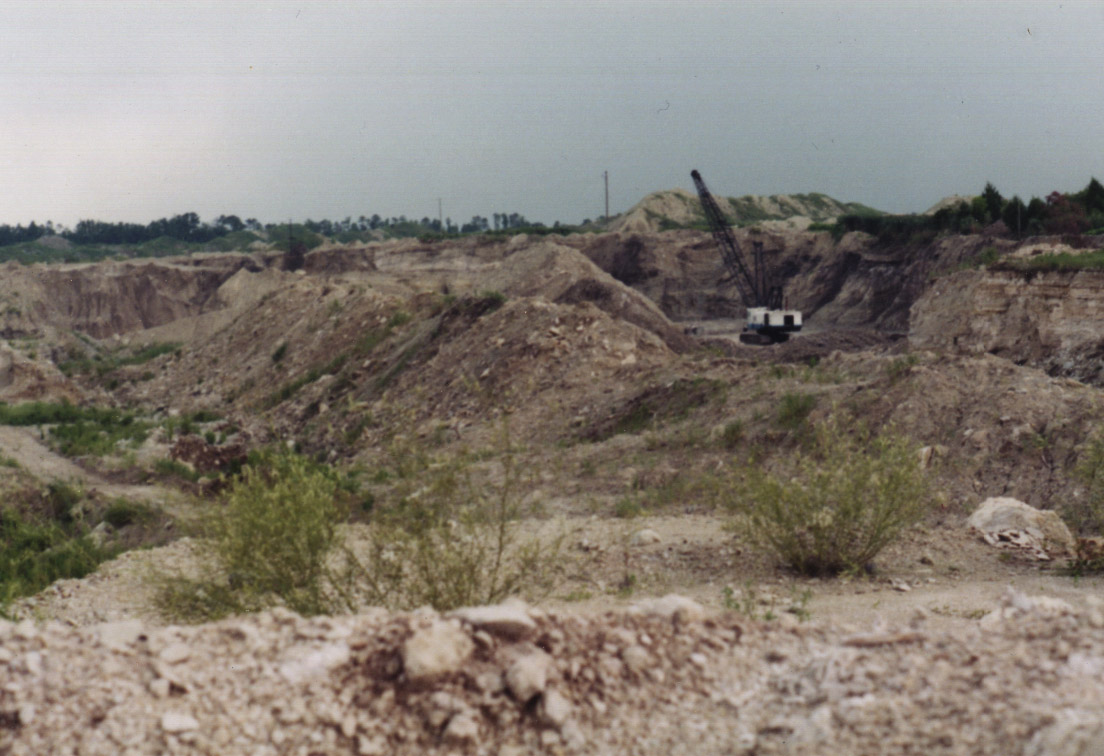


Pectins in matrix found in one of the quarries.
Spring, 2001 - Walker Co, AL
BPS took several trips to an abandoned strip mine, where numerous nodules containing fern spore pods were found. This was on a trip with a visiting paleontologist.
July 21, 2001 - Clarke and Washington Co, AL
BPS members went to a Clarke County site where whale fossils have been found in the past, but none were found on this day. We also collected at a privately owned quarry in Washington County, Alabama, where numerous echinoids, sand dollars, and foraminifera were found.

Forams with a sand dollar showing in the matrix.
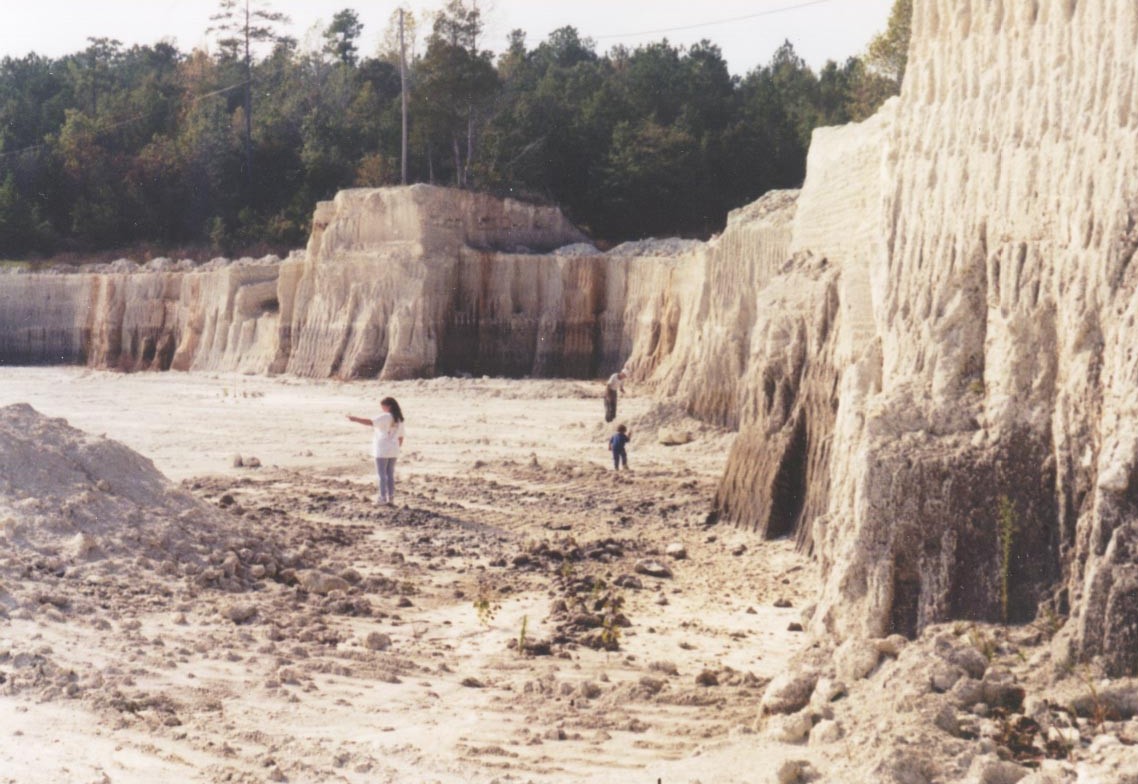
Numerous sand dollars were found in this quarry.
Summer, 2001 - Jefferson Co, AL
Several times during the summer, members collected in north Jefferson county, in an area being cleared for a shopping center.
August 25, 2001 - Colbert Co, AL
BPS members took a long road trip to roadcuts in Colbert County on August 25, where everyone found a good selection of blastoids, brachiopods, trilobites, and other Mississippian age fossils at two separate collecting sites.
Afterwards, we relaxed and cooled off in a creek on some propery owned by one of our members.


